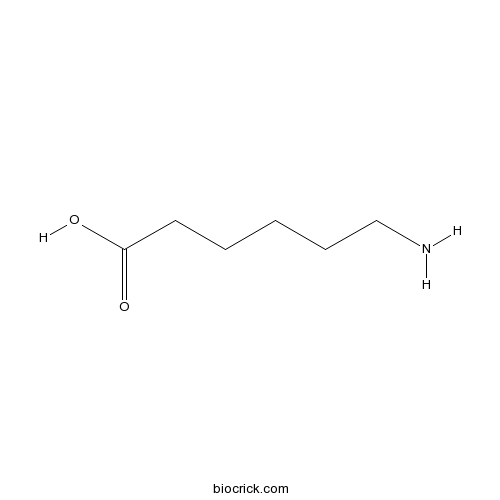(6-)ε-Aminocaproic acidCAS# 60-32-2 |

- Edoxaban tosylate monohydrate
Catalog No.:BCC1545
CAS No.:1229194-11-9
- Otamixaban
Catalog No.:BCC1827
CAS No.:193153-04-7
- Betrixaban
Catalog No.:BCC5118
CAS No.:330942-05-7
- Rivaroxaban
Catalog No.:BCC2292
CAS No.:366789-02-8
- Edoxaban
Catalog No.:BCC1543
CAS No.:480449-70-5
- Apixaban
Catalog No.:BCC2295
CAS No.:503612-47-3
Quality Control & MSDS
3D structure
Package In Stock
Number of papers citing our products

| Cas No. | 60-32-2 | SDF | Download SDF |
| PubChem ID | 564 | Appearance | Powder |
| Formula | C6H13NO2 | M.Wt | 131.17 |
| Type of Compound | N/A | Storage | Desiccate at -20°C |
| Synonyms | EACA; Epsilon-Amino-n-caproic Acid; 6-Aminohexanoic acid | ||
| Solubility | H2O : ≥ 50 mg/mL (381.18 mM) DMSO : < 1 mg/mL (insoluble or slightly soluble) *"≥" means soluble, but saturation unknown. | ||
| Chemical Name | 6-aminohexanoic acid | ||
| SMILES | NCCCCCC(O)=O | ||
| Standard InChIKey | SLXKOJJOQWFEFD-UHFFFAOYSA-N | ||
| Standard InChI | InChI=1S/C6H13NO2/c7-5-3-1-2-4-6(8)9/h1-5,7H2,(H,8,9) | ||
| General tips | For obtaining a higher solubility , please warm the tube at 37 ℃ and shake it in the ultrasonic bath for a while.Stock solution can be stored below -20℃ for several months. We recommend that you prepare and use the solution on the same day. However, if the test schedule requires, the stock solutions can be prepared in advance, and the stock solution must be sealed and stored below -20℃. In general, the stock solution can be kept for several months. Before use, we recommend that you leave the vial at room temperature for at least an hour before opening it. |
||
| About Packaging | 1. The packaging of the product may be reversed during transportation, cause the high purity compounds to adhere to the neck or cap of the vial.Take the vail out of its packaging and shake gently until the compounds fall to the bottom of the vial. 2. For liquid products, please centrifuge at 500xg to gather the liquid to the bottom of the vial. 3. Try to avoid loss or contamination during the experiment. |
||
| Shipping Condition | Packaging according to customer requirements(5mg, 10mg, 20mg and more). Ship via FedEx, DHL, UPS, EMS or other couriers with RT, or blue ice upon request. | ||
| Description | 6-Aminocaproic acid is an antifibrinolytic agent that acts by inhibiting plasminogen activators which have fibrinolytic properties.
Target: Others
6-aminohexanoic acid is a derivative and analogue of the amino acid lysine, which makes it an effective inhibitor for enzymes that bind that particular residue. Such enzymes include proteolytic enzymes like plasmin, the enzyme responsible for fibrinolysis. Aminocaproic acid is also an intermediate in the polymerization of Nylon-6, where it is formed by ring-opening hydrolysis of caprolactam.
Aminocaproic acid is used to treat excessive postoperative bleeding, especially after procedures in which a great amount of bleeding is expected, such as cardiac surgery. Aminocaproic acid can also be used to treat the overdose and/or toxic effects of the thrombolytic pharmacologic agents tissue plasminogen activator and streptokinase [1, 2]. References: | |||||

(6-)ε-Aminocaproic acid Dilution Calculator

(6-)ε-Aminocaproic acid Molarity Calculator
| 1 mg | 5 mg | 10 mg | 20 mg | 25 mg | |
| 1 mM | 7.6237 mL | 38.1185 mL | 76.2369 mL | 152.4739 mL | 190.5924 mL |
| 5 mM | 1.5247 mL | 7.6237 mL | 15.2474 mL | 30.4948 mL | 38.1185 mL |
| 10 mM | 0.7624 mL | 3.8118 mL | 7.6237 mL | 15.2474 mL | 19.0592 mL |
| 50 mM | 0.1525 mL | 0.7624 mL | 1.5247 mL | 3.0495 mL | 3.8118 mL |
| 100 mM | 0.0762 mL | 0.3812 mL | 0.7624 mL | 1.5247 mL | 1.9059 mL |
| * Note: If you are in the process of experiment, it's necessary to make the dilution ratios of the samples. The dilution data above is only for reference. Normally, it's can get a better solubility within lower of Concentrations. | |||||

Calcutta University

University of Minnesota

University of Maryland School of Medicine

University of Illinois at Chicago

The Ohio State University

University of Zurich

Harvard University

Colorado State University

Auburn University

Yale University

Worcester Polytechnic Institute

Washington State University

Stanford University

University of Leipzig

Universidade da Beira Interior

The Institute of Cancer Research

Heidelberg University

University of Amsterdam

University of Auckland

TsingHua University

The University of Michigan

Miami University

DRURY University

Jilin University

Fudan University

Wuhan University

Sun Yat-sen University

Universite de Paris

Deemed University

Auckland University

The University of Tokyo

Korea University
6-Aminocaproic acid is an antifibrinolytic agent that acts by inhibiting plasminogen activators which have fibrinolytic properties.
- Acetylcholine chloride
Catalog No.:BCN2197
CAS No.:60-31-1
- H-Tyr-OH
Catalog No.:BCC3123
CAS No.:60-18-4
- Guanethidine Sulfate
Catalog No.:BCC3789
CAS No.:60-02-6
- EDTA
Catalog No.:BCC7493
CAS No.:60-00-4
- Tagitinin A
Catalog No.:BCN4102
CAS No.:59979-61-2
- Tagitinin F
Catalog No.:BCN4101
CAS No.:59979-57-6
- Carlinoside
Catalog No.:BCN2853
CAS No.:59952-97-5
- Malotilate
Catalog No.:BCC1196
CAS No.:59937-28-9
- 3',4'-dihydro-3'-hydroxy-Xanthyletin
Catalog No.:BCN3680
CAS No.:5993-18-0
- Vicriviroc maleate
Catalog No.:BCC2038
CAS No.:599179-03-0
- Vindesine sulfate
Catalog No.:BCC8266
CAS No.:59917-39-4
- HPI 1
Catalog No.:BCC3938
CAS No.:599150-20-6
- Linoleic acid
Catalog No.:BCN3821
CAS No.:60-33-3
- Acetamide
Catalog No.:BCN4114
CAS No.:60-35-5
- Acetyl-Strophanthidin
Catalog No.:BCC8113
CAS No.:60-38-8
- Tetracycline
Catalog No.:BCC9176
CAS No.:60-54-8
- Methimazole
Catalog No.:BCC3812
CAS No.:60-56-0
- Veratramine
Catalog No.:BCN2965
CAS No.:60-70-8
- Antipyrine
Catalog No.:BCC8834
CAS No.:60-80-0
- Phlorizin
Catalog No.:BCN4126
CAS No.:60-81-1
- Phloretin
Catalog No.:BCN4128
CAS No.:60-82-2
- Adenosine cyclophosphate
Catalog No.:BCN2190
CAS No.:60-92-4
- N-Me-DL-Ala-OH.HCl
Catalog No.:BCC2618
CAS No.:600-21-5
- 11Beta-hydroxyprogesterone
Catalog No.:BCN2211
CAS No.:600-57-7


